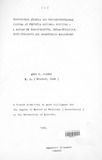| dc.description.abstract | A review of pre-operative, intra-operative,
post-operative and anaesthetio management
of 54 patients, operated on at Kenyatta
National Hospital, for oesophageal atresia
with tracheoesophageal fistula, was done o.
These were patients operated on during
a period of 8 yrs. ( 1976 - 1987 ).
Four aspects of the supportive management
for these patients, during the pre-operative,
intra-oprative and post-operative periods,
were chosen to form the main subject for
this study i e
1). Prophylaxis against and treatment of
pulmonary complications of this congenital
anomaly, during the three periods of
treatment
2). Fluid therapy for these patients, during
the three stages Qf treatment.
3). Body temperature control and maintenance,
during the three periods of management
4). Nutritional management of these patienta,
pre-operatively and post-operatively.
This study sought to establish the mortality
rate in this series of patients and to compare
it with those mortality those mortality rates
reported elsewhere in other centres.
Concerning the four aspects of supportive management
chosen for this study, inadequencies were found as
follows:-
a). Measures taken to prevent pulmonary complications
were inadequate especially during the preoperative
period, with these improving post-operatively 0
b). Fluid therapy was occasionally inadequate both
qualitatively and quantatively, during all the
three periodsof management. Occasionally, fluid
overload was also seen.
c). Body temperature maintenance and regulation
measures were often inadequate, especially during
the pre-operative and intra-operative periods,
with some patients remaining hypothermic during
this two periods of their management.
d). Insufficient use of hyperalimentation where this
was indicated, hence twenty-two of the patients had
no extra nutritional support,
other than interaveuous dextrose solutions.
Some patients were introduced to oral feeding
before radiological screening to rule out
anastomotic leaks. The importance of this
aspect of investigation can not be over emphasised,
since mortality rate amoungest patients who developed
anastomotic leak, was 100 % in this study.
Mortality rates were seen to raise and fall,
depending on the efficency of the supportive
care offered.
Together with these four aspects of supportive
care, other factors affecting survival in patients
born with oesophageal atresia with tracheoesophageal
fistula were reviewed ;
a). Prematurity with low birthweight,
mortality rate was 100 % for babies who
were born prematurely and who weighed less'
than 1800 gms at birth.
b). Age in days at time of operation was also
seen to reflect on mortality in this study.
Survival was less likely, the older the
patient in days at time of operation.
c. Patient's A. S. A. grade on admission, as
determined by their general condition,
presence and severity of systemic illness,
complicating either the oesophageal atresia,
with tracheoesophageal fistula, or other congenital
malformations mortality rate rose, the poorer the
&. S. A. grade of the patient; was at admission.
d). Post-operative complications, amongst which,
alJPiratipn pneumonaa ' and mecha m.caL and lor
technical faults occured most frequently
and were responsible for mortality rate~
of 75 % and 6607% respectively in the groups
of Ratients who developed them.
Inadequate supportive care combined with the other
extra factors listed above caused a mortality rat~
of 61.1% in total, in thia series of patients, which
was thought to be unacceptably high, when compare~
to mortality rates reported from other centres.
Scanty investigations that were considered helpful
in the management of these patients, and inadequate
record keeping , especially during the pre-operative;
and intra-operative periods, were frequently observed.
Anaesthetic techniques applied on these patients
locally, were seen to conrespond well, with
with these applied elsewhere, but monitoring
was minimal, which resulted into failure to
recognise various intra-operative complications.
No intra-operative deaths were recorded but
four patients had cardiac arrests, while two patient
patients developed hypothemia •
Post-operative complications , mainly pulmonary
and circulatory caused high mortality,
Mechanical and lor technical faults, occuring
during the post-operative management of these
patients, also resulted with frequent deaths.
These faults occured mainly in those patients
who remained intubated and were either on
spontenous breathing or mechanical ventilation
post-operatively in the Intensive Care Unit. | en_US |
| dc.description.department | a
Department of Psychiatry, University of Nairobi, ; bDepartment of Mental Health, School of Medicine,
Moi University, Eldoret, Kenya | |

